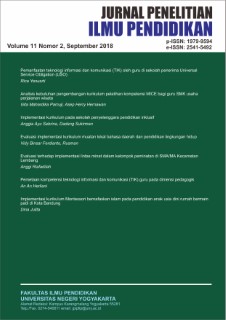Experience, challenges, and engagement amidst pandemic: The online learning to onsite learning
DOI:
https://doi.org/10.21831/jpipfip.v16i1.52298Keywords:
online learning, college student, qualitativeAbstract
The Covid-19 pandemic has forced stakeholders to find the best way to carry out student learning activities through online learning as the best solution during the pandemic. However, the onsite learning system has been switching slowly in the last few months. The current study summarizes the narratives of the challenges and benefits of four undergraduates from the same major who joined online learning and onsite learning during the Covid-19 pandemic. Through a narrative qualitative, the lens examines the students' experiences. The instruments are interviews and diary notes of participants during conducting online and onsite learning amidst the pandemic and analyzed qualitatively. The findings showed that the students deal with four challenges: limited devices, lack of enthusiasm, anxiety, and unexpected disturbance during online learning. Meanwhile, the benefits save time, and cost, are easy to access, and students can learn independently. Moreover, this learning might help the student to become problem solvers and critical thinkers through task-solving activities and learning responsibilities. It also opens opportunities for students to better understand their own abilities in learning.
Pengalaman, tantangan, dan keterlibatan di tengah pandemic: Pembelajaran online hingga pembelajaran luring
Pandemi Covid-19 memaksa para pemangku kepentingan untuk mencari cara terbaik dalam melaksanakan kegiatan belajar siswa melalui pembelajaran online sebagai solusi terbaik di masa pandemi. Namun, sistem pembelajaran di tatap muka telah beralih perlahan dalam beberapa bulan terakhir. Penelitian ini merangkum narasi perihal tantangan dan manfaat dari empat mahasiswa dari jurusan yang sama yang mengikuti pembelajaran online dan pembelajaran di tempat selama pandemi Covid-19. Instrumen yang digunakan berupa wawancara dan catatan harian peserta selama melakukan pembelajaran daring dan luring di tengah pandemi dan dianalisis secara kualitatif. Temuan menunjukkan bahwa siswa menghadapi empat tantangan: perangkat terbatas, kurangnya antusiasme, kecemasan, dan gangguan tak terduga selama pembelajaran online. Sedangkan keuntungannya adalah menghemat waktu, dan biaya, mudah diakses, dan siswa dapat belajar secara mandiri. Selain itu, pembelajaran ini dapat mendukung siswa untuk menjadi sosok pemecah masalah dan pemikir kritis melalui kegiatan pemecahan tugas dan tanggung jawab belajar. Hal ini juga membuka kesempatan bagi siswa untuk lebih memahami kemampuannya sendiri dalam belajar.
References
Adnan, M., & Anwar, K. (2020). Online learning amid the COVID-19 pandemic: Students' perspectives. Journal of Pedagogical Sociology and Psychology, 2(1), 45–51. https://doi.org/10.33902/JPSP.202020261309
Agarwal, S., & Kaushik, J. S. (2020). Student's perception of online learning during Covid pandemic. The Indian Journal of Pediatrics, 87(7), 554–554. https://doi.org/10.1007/s12098-020-03327-7
Aivaz, K. A., & Teodorescu, D. (2022). College students' distractions from learning caused by multitasking in online vs. face-to-face classes: A case study at a public university in Romania. International Journal of Environmental Research and Public Health, 19(18), 11188. https://doi.org/10.3390/ijerph191811188
Dewanti, S. R., & Sujarwo, S. (2021). Development of Instagram and YouTube content videos for online learning. Jurnal Penelitian Ilmu Pendidikan, 14(2), 181–188. https://doi.org/10.21831/jpipfip.v14i2.40253
Dhawan, S. (2020). Online learning: A panacea in the time of COVID-19 crisis. Journal of Educational Technology Systems, 49(1), 5–22. https://doi.org/10.1177/0047239520934018
Dyrbye, L., Cumyn, A., Day, H., & Heflin, M. (2009). A qualitative study of physicians' experiences with online learning in a masters degree program: Benefits, challenges, and proposed solutions. Medical Teacher, 31(2), e40–e46. https://doi.org/10.1080/01421590802366129
Egbert, J. (2020). The new normal?: A pandemic of task engagement in language learning. Foreign Language Annals, 53(2), 314–319. https://doi.org/10.1111/flan.12452
Ferguson, J., & Tryjankowski, A. M. (2009). Online versus face"to"face learning: Looking at modes of instruction in Master's"level courses. Journal of Further and Higher Education, 33(3), 219–228. https://doi.org/10.1080/03098770903026149
Festiyed, F., Novitra, F., Yohandri, Y., & Asrizal, A. (2022). Networked-based inquiry: An effective physics learning in the new normal Covid-19 era in Indonesia. International Journal of Instruction, 15(2), 997–1016. https://doi.org/10.29333/iji.2022.15255a
Hamann, K., Pollock, P. H., & Wilson, B. M. (2012). Assessing student perceptions of the benefits of discussions in small-group, large-class, and online learning contexts. College Teaching, 60(2), 65–75. https://doi.org/10.1080/87567555.2011.633407
Kim, K.-J., Liu, S., & Bonk, C. J. (2005). Online MBA students' perceptions of online learning: Benefits, challenges, and suggestions. The Internet and Higher Education, 8(4), 335–344. https://doi.org/10.1016/j.iheduc.2005.09.005
Marshall, C., & Rossman, G. (2016). Designing qualitative research (6 ed). Sage.
Megatsari, H., Laksono, A. D., Ibad, M., Herwanto, Y. T., Sarweni, K. P., Geno, R. A. P., & Nugraheni, E. (2020). The community psychosocial burden during the Covid-19 pandemic in Indonesia. Heliyon, 6(10), e05136. https://doi.org/10.1016/j.heliyon.2020.e05136
Morgan, H. (2020). Best practices for implementing remote learning during a pandemic. The Clearing House: A Journal of Educational Strategies, Issues and Ideas, 93(3), 135–141. https://doi.org/10.1080/00098655.2020.1751480
Mulyono, H., Suryoputro, G., & Jamil, S. R. (2021). The application of WhatsApp to support online learning during the Covid-19 pandemic in Indonesia. Heliyon, 7(8), e07853. https://doi.org/10.1016/j.heliyon.2021.e07853
Rasmitadila, R., Aliyyah, R. R., Rachmadtullah, R., Samsudin, A., Syaodih, E., Nurtanto, M., & Tambunan, A. R. S. (2020). The perceptions of primary school teachers of online learning during the Covid-19 pandemic period: A case study in Indonesia. Journal of Ethnic and Cultural Studies, 90–109. https://doi.org/10.29333/ejecs/388
Rotas, E. E., & Cahapay, M. B. (2020). Difficulties in remote learning: Voices of Philippine university students in the wake of COVID-19 crisis. Asian Journal of Distance Education, 15(2), 147–158. https://eric.ed.gov/?id=EJ1285295
Russell, V. (2020). Language anxiety and the online learner. Foreign Language Annals, 53(2), 338–352. https://doi.org/10.1111/flan.12461
Setyaningsih, V. I., & Rahmawati, L. E. (2021). Student responses to online learning of Indonesian language subjects based on LMS moodle. Jurnal Penelitian Ilmu Pendidikan, 14(2), 171–180. https://doi.org/10.21831/jpipfip.v14i2.40149
Silalahi, W. P., & Sitorus, F. R. (2021). From frustration to enlightenment: Experiences of student exchange program awardees in Taiwan. F1000Research, 10, 468. https://doi.org/10.12688/f1000research.51865.2
Sparrow, R., Dartanto, T., & Hartwig, R. (2020). Indonesia under the new normal: Challenges and the way ahead. Bulletin of Indonesian Economic Studies, 56(3), 269–299. https://doi.org/10.1080/00074918.2020.1854079
Wang, C. (2022). Comprehensively summarizing what distracts students from online learning: A literature review. Human Behavior and Emerging Technologies, 2022, 1–15. https://doi.org/10.1155/2022/1483531
Downloads
Published
How to Cite
Issue
Section
Citation Check
License









